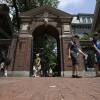On an East Boston street, the door to a nondescript-looking restaurant leads to another world—a world where many people speak Spanish with the particular accent of a small Colombian mountain town named Donmatías.
“Donmatías was this little village with agricultural economy, like milk, dairy products, pork,” said Jorge Caraballo, a graduate student from a Colombian city near Donmatías.
Caraballo’s doing his master’s project at Northeastern about the unique way Donmatíans recreated their community in East Boston. People say now there are more of the townspeople here than in Colombia. They’re among the newest wave of immigrants to call East Boston home. The area has a long relationship with immigrants—once serving as a springboard for Irish and Russian-Jewish newcomers. But East Boston’s tradition of incubating new Americans might be changing, as housing costs rise and young professionals move in.
That trend may break up the relocated Donmatíans—a community that was first disrupted in the 1960s, when it became an unlikely front line in the Catholic Church’s internal struggle over its ideological direction. A liberal priest devoted to a new, seemingly radical path—to help the poor—was assigned to Donmatías, a town centered around the church. The priest organized poor farmers, angering the handful of rich families, who asked the church to remove the priest. The New York Times and Time Magazine did stories when the priest refused to leave, and instead set up his own services, school, and workers' cooperative.
“So international media looked at this little village battle of the battles inside the church where leftists priests, revolutionary priests, were standing with the poor,” Caraballo said.
Eventually there was violence. A rich man was killed. Wealthy families fled the town. Donmatías' economy died. People started relocating to East Boston, possibly because word spread there were jobs in Massachusetts textile mills. The move to East Boston almost became a coming-of-age tradition in Donmatías.
They’re still coming—some, without documentation, like a young woman named Daniela. We’re not using Daniela’s full name because she’s worried she doesn’t have permission to be here. She talked about coming here three years ago to be with her boyfriend, and staying to work at a wire transfer business, bakery, and grocery store.
Remittances from Donmatías in East Boston have rejuvenated the original town in Colombia. Daniela says family there is constantly asking her to send stuff—sometimes because someone else on their street with a relative in East Boston has it.
Unfortunately, money’s tight. Daniela doesn’t know how long it’ll make sense to be here. She pays $650 a month to share a three-bedroom apartment—and spends more on top of that for utilities and the internet.
Like many East Boston Donmatíans, Daniela streams services online from the town church in Colombia, and hopes to go back home one day. But that devotion to the original town can mean Donmatíans don’t have the deepest roots in East Boston, which frustrates the few townspeople fighting to preserve their relocated community.
Donmatías transplant Adrián Cadavid owns Café Gigú, near the Maverick T station. He’s seeing housing prices rise and worries there’s nothing anyone can do to keep the American Donmatíans from slipping away.
“He’s like a community leader and he thinks about this a lot,” Cadavid said, with Caraballo translating, “because he says that this diversity—this Latino diversity is what makes this neighborhood nice and rich. So that’s beginning to get lost.”
After migrating to keep their culture alive, the Donmatías community may be at risk again—and like before, the cause might be the divide between rich and poor. Because Cadavid says the only way to combat gentrification is for wealthier Donmatíans who own businesses and homes to resist selling to developers who want to put up more luxury condo buildings—that, in turn, drive poor Donmatíans out.



